While paper quilling might seem like a kid’s craft, it has been shown to promote cognitive development and improve focus and memory. Plus, it’s inexpensive and easy to get started.
Brodskaya’s work has gone from decorative flourishes to dimensional lettering and illustrative quilling art that has made its way into national ad campaigns and homes around the world.
Techniques
Paper quilling is an artistic medium that uses coiled paper to create intricate designs, images, and even messages. The paper is manipulated using a variety of tools, including a slotted tool with a needle around which the paper is rolled. Once a shape is rolled to the desired length, it can be glued to its final location on the piece of art.
To add texture to your pieces, use a tool that crimps the strip of paper. Simply line the strip up against the wheels and turn the handle. This gives the strip a beehive appearance that adds a touch of elegance to any design.
Artist Yulia Brodskaya often uses her quilling skills to create portraits that celebrate nature and people. Her work is often colorful, and she uses the direction of the rolled paper to mimic the look of a brushstroke. She also produces many works that are dedicated to flowers. To help her craft, she uses a circle sizing board that is designed to help achieve consistency in the size of her circles.
Materials
Paper quilling is a popular craft that dates back hundreds of years. It involves rolling and pinching strips of colorful paper into a variety of shapes. This can be used to decorate cards, gift wrap, boxes, or picture frames. Artists like Yulia Brodskaya also use it to create 3D stand-alone pieces of art.
Precut quilling strips are available in a wide range of colors from most craft stores and online retailers. These strips are generally made from text weight paper that is acid-free.
It is also possible to make your own strips by cutting them from a piece of cardstock or other paper with scissors. Some craftsers prefer to purchase a quilling kit that includes all of the necessary materials for a new project.
Quilling requires focus and attention to detail, which is a great way to exercise the brain. It can also improve memory, which is important for children. Moreover, practicing this craft may help children develop fine motor skills and hand-eye coordination.
Patterns
The decorative art of paper quilling has been around since the 15th century and has enjoyed a comeback in recent years, with intricate patterns seen across Instagram, Pinterest, TikTok and even high-profile posters. While it may seem intimidating at first, if you’ve got the skills to curl a piece of paper and glue it into shape, then you can make a variety of designs.
Many new paper quilling enthusiasts find it helpful to use a premade pattern when starting out. There are a variety of these available online for free and can help guide your technique while helping you create something that looks great on a birthday card or as wall art.
There are a few basic shapes that can be made with paper quilling, including tight rolls, loose circles and teardrops. You can also make a square by turning a tight roll into a rectangle and pinching the ends. You can also make a heart by folding a strip of loose circle into a crease and then rolling each end inwards.
Getting Started
Paper quilling is a fun hobby that can be enjoyed by people of all ages. Kids in particular may find it calming and engaging, which can help develop their hand-eye coordination and fine motor skills. Working with small items can also boost self-esteem and confidence levels.
Once you get the hang of basic quilling techniques, try experimenting with different designs. There are countless patterns available online, and some talented quillers like Yulia Brodskaya have taken this art to new heights by creating whimsical novels or true works of art out of rolled pieces of paper.
If you’re a beginner, it’s best to start with pre-cut strips of paper in varying colors and widths. A circle sizing board can be a great tool to have as well, as it will ensure that you roll your shapes consistently. You’ll also want to have a work board on hand, such as a corkboard or styrofoam, to map out your design and hold the glued shapes in place while they dry.Paper Quilling Art

